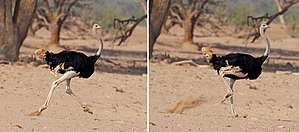双足步行 - 维基百科,自由的百科全书
此條目可参照英語維基百科相應條目来扩充。 |
此條目需要补充更多来源。 (2021年9月26日) |

双足步行[4]或双足运动(英語:bipedalism)是动物在陆地上的一种运动方式,动物通过移动两个后肢或后腿行进。能够进行这种运动的动物被称为双足动物,依照此原理制造的仿生机器人则会被称为双足机器人。双足运动通常包含步行、跑步和跳躍。
现存动物中很少有主要依靠双足运动在陆地上移动的。哺乳动物的双足运动历经多次演化,目前能双足运动的哺乳动物有袋鼠科、更格卢鼠, 跳兔[5]、彈鼠、穿山甲和人族猿猴(南猿和人类),此外还有几个现已灭绝的种类,这些动物各自独立演化出了双足运动的能力。三叠纪期间,有几个主龍類动物(有鳄鱼和恐龙)也发展出了双足运动能力,其中双足恐龙在日常生活中已双足运动为主。现代的鸟类就是由完全凭靠双足移动的獸腳亞目演化而来。
有的现生动物会短时间切换为双足运动模式。有的蜥蜴在奔跑时会双足移动以躲避天敌。许多灵长类和熊在探索四周、觅食时会双足站立,不过也有时候会双足步行一段距离。一些树栖灵长类物种(如长臂猿和大狐猴)在下地时会改为完全双足运动。许多动物在打架或交配时会双足站立。有的动物在求偶、警戒、吓唬竞争者或捕食者时会双足站立,但不会靠双足四处移动。
参见
[编辑]注
[编辑]参考资料
[编辑]- ^ Stewart, D. A Bird Like No Other. National Wildlife. National Wildlife Federation. 2006-08-01 [2014-05-30]. (原始内容存档于2012-02-09).
- ^ Davies, S.J.J.F. Birds I Tinamous and Ratites to Hoatzins. Hutchins, Michael (编). Grzimek's Animal Life Encyclopedia 8 2nd. Farmington Hills, MI: Gale Group: 99–101. 2003. ISBN 978-0-7876-5784-0.
- ^ Penny, M. The Secret World of Kangaroos. Austin, TX: Raintree Steck-Vaughn. 2002: 22 [2021-09-26]. ISBN 978-0-7398-4986-6. (原始内容存档于2021-08-16).
- ^ bipedalism - 雙足步行. 国家教育研究院. [2021-09-26]. (原始内容存档于2021-09-26).
- ^ Heglund, NC; Cavagna, GA; Taylor, CR. Energetics and mechanics of terrestrial locomotion. III. Energy changes of the centre of mass as a function of speed and body size in birds and mammals. Journal of Experimental Biology. 1982, 97: 41–56. PMID 7086349. doi:10.1242/jeb.97.1.41.
拓展阅读
[编辑]- Darwin, C., "The Descent of Man and Selection in Relation to Sex", Murray (London), (1871).
- Dart, R. A., "Australopithecus africanus: The Ape Man of South Africa" Nature, 145, 195–199, (1925).
- Dawkins, R., "The Ancestor's Tale", Weidenfeld and Nicolson (London), (2004).
- DeSilva, J., “First Steps: How Upright Walking Made Us Human” Harper Collins (New York), (2021)
- Hewes, G. W., "Food Transport and the Origin of Hominid Bipedalism" American Anthropologist, 63, 687–710, (1961).
- Hunt, K. D., "The Evolution of Human Bipedality" Journal of Human Evolution, 26, 183–202, (1994).
- Isaac, G. I., "The Archeological Evidence for the Activities of Early African Hominids" In:Early Hominids of Africa (Jolly, C.J. (Ed.)), Duckworth (London), 219–254, (1978).
- Jablonski, N.G.; Chaplin, G. Origin of Habitual Terrestrial Bipedalism in the Ancestor of the Hominidae. Journal of Human Evolution. 1993, 24 (4): 259–280. doi:10.1006/jhev.1993.1021.
- Lovejoy, C. O. The Origin of Man. Science. 1981, 211 (4480): 341–350. Bibcode:1981Sci...211..341L. PMID 17748254. doi:10.1126/science.211.4480.341.
- Tanner, N. M., "On Becoming Human", Cambridge University Press (Cambridge), (1981)
- Wescott, R.W. Hominid Uprightness and Primate Display. American Anthropologist. 1967, 69 (6): 738. doi:10.1525/aa.1967.69.6.02a00110.
- Wheeler, P. E. (1984) "The Evolution of Bipedality and Loss of Functional Body Hair in Hominoids." Journal of Human Evolution, 13, 91–98,
- Vrba, E. The Pulse that Produced Us. Natural History. 1993, 102 (5): 47–51.
外部链接
[编辑]- The Origin of Bipedalism (页面存档备份,存于互联网档案馆)
- 人类时间表 (页面存档备份,存于互联网档案馆)——美国国立自然历史博物馆史密森尼学会(2016年8月)


 French
French Deutsch
Deutsch
